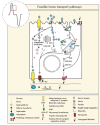Heme in intestinal epithelial cell turnover, differentiation, detoxification, inflammation, carcinogenesis, absorption and motility
- PMID: 16865768
- PMCID: PMC4087737
- DOI: 10.3748/wjg.v12.i27.4281
Heme in intestinal epithelial cell turnover, differentiation, detoxification, inflammation, carcinogenesis, absorption and motility
Abstract
The gastrointestinal tract is lined by a simple epithelium that undergoes constant renewal involving cell division, differentiation and cell death. In addition, the epithelial lining separates the hostile processes of digestion and absorption that occur in the intestinal lumen from the aseptic environment of the internal milieu by defensive mechanisms that protect the epithelium from being breached. Central to these defensive processes is the synthesis of heme and its catabolism by heme oxygenase (HO). Dietary heme is also an important source of iron for the body which is taken up intact by the enterocyte. This review describes the recent literature on the diverse properties of heme/HO in the intestine tract. The roles of heme/HO in the regulation of the cell cycle/apoptosis, detoxification of xenobiotics, oxidative stress, inflammation, development of colon cancer, heme-iron absorption and intestinal motility are specifically examined.
Figures






References
-
- Cheng H, Leblond CP. Origin, differentiation and renewal of the four main epithelial cell types in the mouse small intestine. I. Columnar cell. Am J Anat. 1974;141:461–479. - PubMed
-
- Maines MD. Heme oxygenase: function, multiplicity, regulatory mechanisms, and clinical applications. FASEB J. 1988;2:2557–2568. - PubMed
-
- Ponka P. Cell biology of heme. Am J Med Sci. 1999;318:241–256. - PubMed
-
- Ryter SW, Tyrrell RM. The heme synthesis and degradation pathways: role in oxidant sensitivity. Heme oxygenase has both pro- and antioxidant properties. Free Radic Biol Med. 2000;28:289–309. - PubMed
Publication types
MeSH terms
Substances
LinkOut - more resources
Full Text Sources

